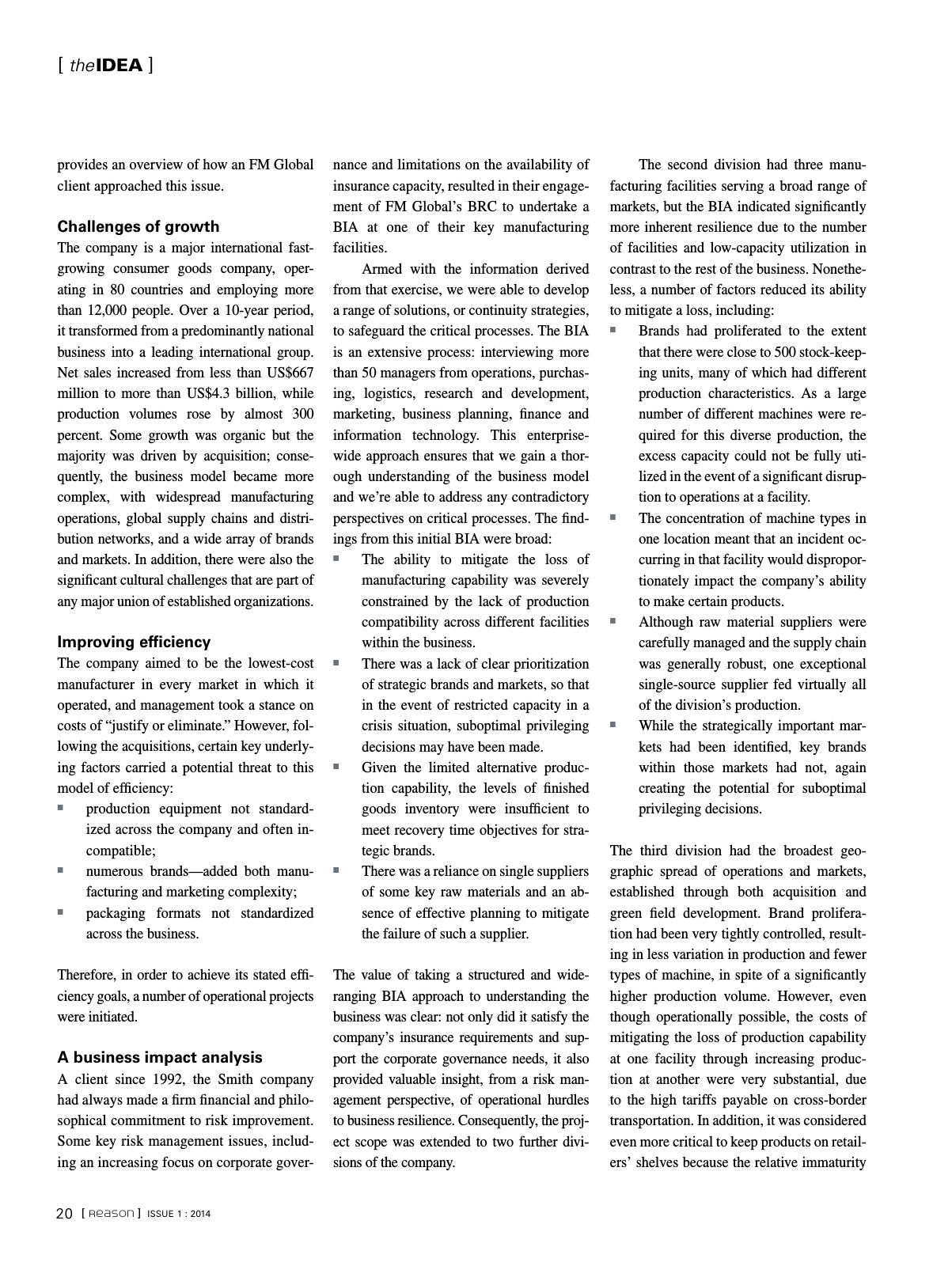Reason Mag Q1 2014 Seite 20
Hinweis: Dies ist eine maschinenlesbare No-Flash Ansicht.Klicken Sie hier um zur Online-Version zu gelangen.
Inhalt
provides an overview of how an FM Global client approached this issue Challenges of growth The company is a major international fast growing consumer goods company oper ating in 80 countries and employing more than 12 000 people Over a 10 year period it transformed from a predominantly national business into a leading international group Net sales increased from less than US 667 million to more than US 4 3 billion while production volumes rose by almost 300 percent Some growth was organic but the majority was driven by acquisition conse quently the business model became more complex with widespread manufacturing operations global supply chains and distri bution networks and a wide array of brands and markets In addition there were also the signi cant cultural challenges that are part of any major union of established organizations Improving efficiency The company aimed to be the lowest cost manufacturer in every market in which it operated and management took a stance on costs of justify or eliminate However fol lowing the acquisitions certain key underly ing factors carried a potential threat to this model of ef ciency Q production equipment not standard ized across the company and often in compatible Q numerous brands added both manu facturing and marketing complexity Q packaging formats not standardized across the business Therefore in order to achieve its stated ef ciency goals a number of operational projects were initiated A business impact analysis A client since 1992 the Smith company had always made a rm nancial and philo sophical commitment to risk improvement Some key risk management issues includ ing an increasing focus on corporate gover nance and limitations on the availability of insurance capacity resulted in their engage ment of FM Global s BRC to undertake a BIA at one of their key manufacturing facilities Armed with the information derived from that exercise we were able to develop a range of solutions or continuity strategies to safeguard the critical processes The BIA is an extensive process interviewing more than 50 managers from operations purchas ing logistics research and development marketing business planning nance and information technology This enterprise wide approach ensures that we gain a thor ough understanding of the business model and we re able to address any contradictory perspectives on critical processes The nd ings from this initial BIA were broad Q The ability to mitigate the loss of manufacturing capability was severely constrained by the lack of production compatibility across different facilities within the business Q There was a lack of clear prioritization of strategic brands and markets so that in the event of restricted capacity in a crisis situation suboptimal privileging decisions may have been made Q Given the limited alternative produc tion capability the levels of nished goods inventory were insuf cient to meet recovery time objectives for stra tegic brands Q There was a reliance on single suppliers of some key raw materials and an ab sence of effective planning to mitigate the failure of such a supplier The value of taking a structured and wide ranging BIA approach to understanding the business was clear not only did it satisfy the company s insurance requirements and sup port the corporate governance needs it also provided valuable insight from a risk man agement perspective of operational hurdles to business resilience Consequently the proj ect scope was extended to two further divi sions of the company The second division had three manu facturing facilities serving a broad range of markets but the BIA indicated signi cantly more inherent resilience due to the number of facilities and low capacity utilization in contrast to the rest of the business Nonethe less a number of factors reduced its ability to mitigate a loss including Q Brands had proliferated to the extent that there were close to 500 stock keep ing units many of which had different production characteristics As a large number of different machines were re quired for this diverse production the excess capacity could not be fully uti lized in the event of a signi cant disrup tion to operations at a facility Q The concentration of machine types in one location meant that an incident oc curring in that facility would dispropor tionately impact the company s ability to make certain products Q Although raw material suppliers were carefully managed and the supply chain was generally robust one exceptional single source supplier fed virtually all of the division s production Q While the strategically important mar kets had been identi ed key brands within those markets had not again creating the potential for suboptimal privileging decisions The third division had the broadest geo graphic spread of operations and markets established through both acquisition and green eld development Brand prolifera tion had been very tightly controlled result ing in less variation in production and fewer types of machine in spite of a signi cantly higher production volume However even though operationally possible the costs of mitigating the loss of production capability at one facility through increasing produc tion at another were very substantial due to the high tariffs payable on cross border transportation In addition it was considered even more critical to keep products on retail ers shelves because the relative immaturity 20 Reason ISSUE 1 2014 the IDEA
